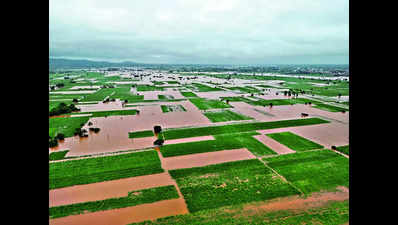- News
- City News
- kolhapur News
- Kolhapur dist logs highest crop damage across state
Trending
Kolhapur dist logs highest crop damage across state

A week back, the crop damage was recorded on 60,000 hectares across the state.

A senior agriculture department official said, “Most of the affected crops were in crucial growth stages, having been in the ground for 40-45 days post-sowing. Unfortunately, the window for resowing has also closed. We’ve observed severe soil erosion in low-lying regions adjacent to water bodies. About 500 hectares of arable land has been washed away in the floods. By the time these eroded lands are reclaimed and prepared for cultivation, we’ll be well into Sept. This timing effectively rules out resowing of kharif crops for these areas. Affected farmers may shift their focus to rabi crops now.”
The agriculture department in Kolhapur district has started the crop damage assessment in the areas where floodwater has receded.
District agriculture officer Ajay Kulkarni said, “The farmlands in the district were inundated after heavy rainfall for the last 10-15 days. The work for assessing the crop damage has started on a war footing. Farmers whose fields were inundated should submit a copy of Eight A form, Aadhaar card and photocopies of bank passbook to agriculture assistants.”
Farmers who applied for the crop insurance scheme and suffered crop loss because of floods should immediately register their complaint on the insurance app.
“Crops in the waterlogged fields can be affected by pests and diseases owing to heavy rainfall. For this, as soon as the rain subsides, the farmers should spray insecticides and fungicides on the crops like rice, soyabean, ragi, groundnuts, and sugar cane as per the guidelines of the University of Agriculture,” Kulkarni had said.
Mahesh Shelke, a farmer from Junnar, said, “Farm plots, especially in ghat areas and near rivers, were washed away. My horticultural crops, particularly pomegranates, were severely affected. The fruit was ready for harvest, but the damage caused prices to plummet from Rs 400 per kg to Rs 200 for export-quality produce.”
In the Konkan region, farmer Prathmesh Jadhav said there had been widespread impact on farms next to rivers.
“Paddy crops near riverbanks suffered the most damage. Resowing is no longer an option for affected farmers. Approximately 300 acres managed by farmers in my producer company have been impacted, which is likely to significantly reduce overall yields,” he said.
Kailas Dakhore, an agro-meteorologist at Vasantrao Naik Marathwada Agricultural University, said, “Prolonged submersion often causes irreversible physiological stress to plants. This typically leads to reduced yields. Soyabean, tur and cotton are particularly vulnerable to excess water, which can cause irreversible damage. Even taller sugar cane crops can be damaged by extended inundation. For black gram in the pod formation stage, these conditions increase the risk of fungal infections and other diseases/pests.”
End of Article
FOLLOW US ON SOCIAL MEDIA










